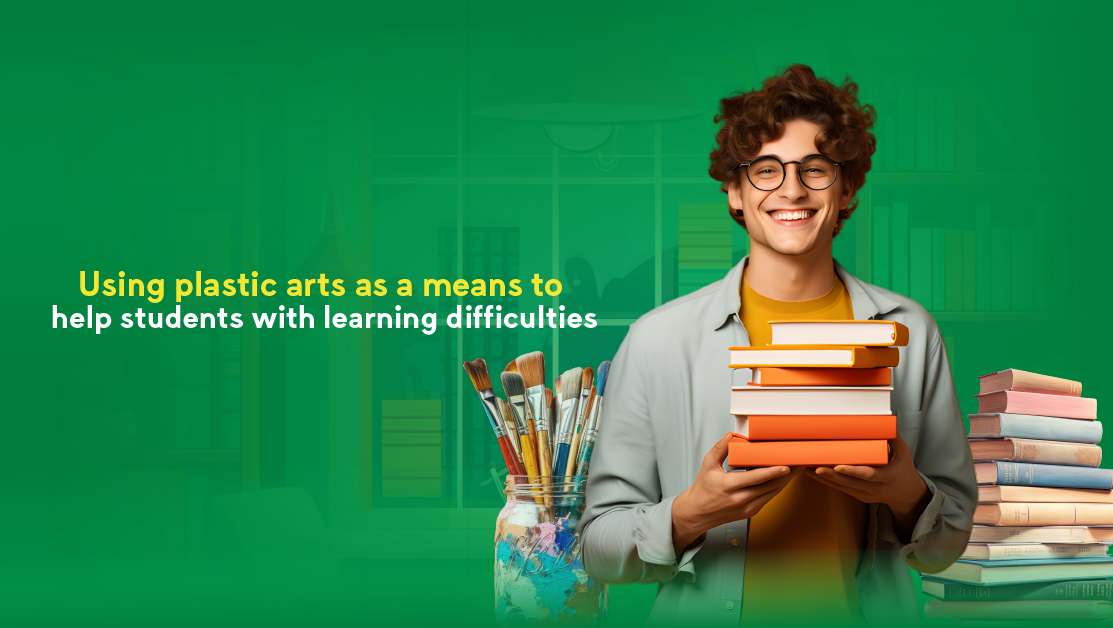
Students with learning disabilities are an important and diverse group of students who face challenges in learning that go beyond what can be explained simply by general mental processes. These difficulties include a wide range of disorders and delays in areas such as reading, writing, arithmetic, reasoning, and self-expression.
The importance of teaching fine arts to students with learning difficulties
Regarding the importance of teaching fine arts to students with learning difficulties, there are several important aspects:
Creative expression and emotional outlet
- Plastic arts provide students with learning disabilities an opportunity to express themselves and display their feelings and ideas in a creative way.
- This creative expression helps them vent and deal with their feelings better.
Developing motor and cognitive skills
- Practicing fine arts requires fine motor skills and good visual perception.
- This practice helps develop these skills in students with learning disabilities.
Building confidence and self-esteem
- Completing artistic works enhances students’ self-confidence and raises their self-esteem.
- This in turn helps them cope better with their educational challenges.
Multisensory learning
- Plastic arts include the use of various senses, such as sight, touch, and movement.
- This multisensory learning is suitable for students with learning difficulties and helps them comprehend and understand.
Comprehensive personality development
- Learning plastic arts contributes to developing multiple aspects of the student’s personality, such as creativity, critical thinking, and social skills.
- This comprehensive personality development reflects positively on their educational performance.
In general, plastic arts are a valuable tool for enhancing the growth of students with learning difficulties on various cognitive, psychological, and social levels. They help them express themselves and acquire skills and confidence that contribute to improving their academic performance.
What are learning difficulties?
Learning difficulties are a group of disorders that affect an individual’s ability to learn and comprehend effectively. These difficulties appear in different areas, such as:
- Reading: Difficulty in comprehending what is read and decoding words.
- Writing: Difficulty in written expression, organization, and dictation.
- Mathematics: Difficulty understanding mathematical concepts and processes.
- Perception and memory: Difficulty processing information effectively and remembering it.
- Attention and concentration: Difficulty paying attention and concentrating for sufficient periods of time.
- Organization and planning: Difficulty organizing and planning ideas and tasks.
These difficulties arise as a result of imbalances in brain function without being linked to intellectual, sensory, or emotional problems. They affect the student’s performance in school, even though he may be intelligent and do not have obvious disabilities. Dealing with learning difficulties requires special educational interventions and adapting methods and curricula to help students. To overcome it.
Types of learning difficulties
There are several main types of learning difficulties, the most important of which are:
Developmental learning difficulties
- These include difficulties with language, perception, thinking and memory.
- They appear in the early stages of growth and development.
- It may affect academic learning at later stages.
Academic learning difficulties
- Difficulties in reading, writing and mathematics.
- It appears clearly during the educational stages.
- It may be the result of developmental difficulties or other environmental factors.
Cognitive learning difficulties
- These include difficulties with attention, perception, memory and thinking.
- May affect general cognitive abilities.
- Developmental and academic learning difficulties may accompany.
Social and behavioral learning difficulties
- Difficulties in social interaction and self-regulation of behavior.
- May be associated with developmental or academic difficulties.
- It may affect adjustment and academic success.
These different types of learning difficulties may overlap and intertwine, requiring comprehensive assessment and multiple interventions to help students.
How overcoming learning difficulties helps students improve their academic performance
Overcoming learning difficulties helps students improve their academic performance in several ways, the most important of which are:
Improve understanding and comprehension
- Personalized pedagogical interventions help students better understand educational concepts and materials.
- Help them build a solid foundation of knowledge and skills.
Improving academic performance
- Focusing on developing weak skills leads to improved performance in various academic subjects.
- Developing effective learning strategies increases their ability to complete tasks and assignments.
Increase confidence and motivation
- Feeling successful and improving enhances students’ confidence in themselves and their abilities.
- Support and encouragement increase their motivation to learn and achieve.
Improve self-regulation and life skills
- Learning organization and planning strategies reflects positively on students’ life skills.
- Developing problem-solving and coping skills helps them deal with academic and personal challenges.
Reducing behavioral and emotional problems
- Dealing with learning difficulties reduces frustration, anxiety, and behavioral problems.
- This in turn is reflected in improved participation and performance in class.
In general, enabling students to overcome learning difficulties contributes significantly to improving their academic performance and their overall educational and personal potential.
The importance of improving students’ concentration during the exam
Improving students’ concentration during exams is of great importance, and the most important of this importance can be summarized in the following points:
Increase understanding and comprehension
- Appropriate focus helps students understand exam questions and relate them to the information learned.
- This in turn improves their ability to answer accurately and objectively.
Improve performance and results
- The ability to concentrate and control attention enables students to perform better on the exam.
- This is reflected in the grades and results they get.
Reduce errors and haste
- Focus helps students to be careful and accurate in answering, and avoid mistakes resulting from haste.
- This enhances the reliability and validity of students’ answers.
Manage time better
- Proper concentration helps students plan well to complete the exam on time.
- Reduces the possibility of wasting time or focusing on unimportant aspects.
Reduce anxiety and stress
- The ability to concentrate helps control feelings of anxiety and stress during the exam.
- This in turn improves the overall performance of students.
Overall, improving students’ concentration during exams contributes significantly to improving their academic results and educational achievements and is crucial to their future success.
What are some strategies that can be used to improve students’ concentration during exams?
There are several strategies that students can use to improve their focus during exams, including:
Advance planning and preparation
- Ensure you understand the exam requirements and focus on key topics.
- Prepare a study schedule and organize time well.
Practice deep breathing and relaxation
- Do some deep breathing exercises to relieve stress and anxiety.
- Try relaxation techniques such as meditation before taking the exam.
Maintain a healthy lifestyle
- Get enough sleep and healthy food before the exam.
- Do some physical exercises to help relax.
Focus on the present
- Pay attention to the present moment and not be distracted by negative thoughts about the past or future.
- Use meditation techniques to stay in the present moment.
Manage time effectively
- Allocate a specific time for each question and stick to it.
- Avoid spending too much time on difficult questions without completing the rest of the exam.
Ask for help when needed
- Connect with teachers or mentors for additional tips and guidance.
- Take advantage of exam skills development courses if possible.
Applying a combination of these strategies can help students significantly improve their focus and performance during exams.
What are the prominent characteristics by which learning difficulties can be identified?
There are a set of prominent characteristics through which students’ learning difficulties can be identified, including:
Difficulties in reading and writing
- Difficulty in perception and reading comprehension
- Also, difficulty in written expression and linguistic structure
- Difficulty in mastering spelling and grammar skills
Difficulties in arithmetic and mathematics skills
- Difficulty understanding basic mathematical concepts and operations
- There is also difficulty in solving multi step mathematical problems
- Difficulty performing mathematical operations correctly
Weakness in cognition and memory
- Difficulty remembering and retrieving information
- There is also a weakness in attention and concentration on tasks
- Difficulty processing information and understanding relationships
Problems with social skills and self-regulation
- Difficulty in communication and social interaction
- Difficulty organizing time, tasks, and managing behavior
- Inability to control emotions and excessive movements
Discrepancy between cognitive abilities and academic performance
- There is a gap between capabilities and academic results
- Having high mental abilities is not reflected in academic achievement
The presence of a group of these recurring and clear characteristics in a student may be an indication of the presence of learning difficulties that require appropriate diagnosis and intervention.
Can teachers provide appropriate support for students with learning disabilities?
Teachers can provide appropriate support for students with learning difficulties by following the following strategies:
Early diagnosis and immediate intervention
- Identify the salient characteristics of difficulties and refer the student for evaluation and diagnosis.
- Apply individual and group educational strategies to address weaknesses.
Modifications and adaptations in the educational environment
- Modifying educational activities and materials to suit the student’s needs.
- Providing assistive tools and techniques to enhance learning.
- Providing an organized and supportive learning environment.
Positive reinforcement and constant motivation
- Providing constructive feedback and encouraging efforts.
- Highlighting strengths and achievements to build confidence and motivation.
Collaboration with the family and the multidisciplinary team
- Family involvement in the learning process and coordination of efforts.
- Coordination with specialists such as counselors and psychologists.
Professional development and continuous updating of educational practices
- Follow the latest research and effective strategies in the field of learning difficulties.
- Participation in specialized professional development programs.
Through these strategies, teachers can empower students with learning disabilities and improve their chances of achieving academic success.
What are some assistive tools and techniques that teachers can use to enhance learning for students with learning disabilities?
There are many tools and assistive techniques that teachers can use to enhance learning for students with learning difficulties, the most prominent of which are:
Educational software and applications
- Programs for reading texts aloud.
- Text to voice conversion programs.
- Applications for creating mind maps and diagrams.
- Interactive educational programs in various academic subjects.
Assistive technologies
- Screen readers and text magnifiers.
- Electronic pens and handwriting tablets.
- Audio and video recording devices to document information.
Multimedia and visual technologies
- Use pictures and illustrations to explain concepts.
- Visual presentations and educational videos.
- Use colors and visual formats to organize information.
Organization and planning tools
- Task and time management software.
- Concept maps and visual organizations.
- Schedules and individual educational plans.
Interactive and collaborative technologies
- E-learning and virtual communication platforms.
- Collaboration and group participation tools.
- Educational games and interactive applications.
Using these tools and techniques appropriately helps meet the needs of students with learning disabilities and facilitates the learning process in a motivating and effective manner.
Can learning difficulties be cured?
Learning disabilities can be cured in some cases. There are different ways to help students with learning disabilities overcome them:
- Early intervention: Identifying learning difficulties early and providing the necessary assistance can help the child improve his skills and overcome difficulties.
- Specialized Education: Providing special education designed to address a student’s needs can help improve academic and job skills.
- Learning Strategies: Learning effective learning strategies and skills helps students compensate for their weaknesses.
- Psychosocial support: Providing support and encouragement to students with learning difficulties helps them build self-confidence and overcome challenges.
- Assistive Technology: Using assistive technology such as educational software and assistive devices can facilitate the learning process.
With the right help and ongoing support, students with learning disabilities can achieve success and continue to advance in various areas. Learning disabilities should not be viewed as a permanent obstacle.
Do learning difficulties have anything to do with intelligence?
There is some relationship between learning disabilities and intelligence, but not a direct or strong relationship:
- Learning disabilities do not necessarily mean low intelligence. People with learning disabilities may have average or above average intelligence, but have difficulties in specific areas such as reading, mathematics, or expression.
- It is possible that there may be a slight decline in the level of intelligence in some individuals with learning difficulties, but not permanently or definitively. Intelligence may be in the normal range, but with difficulties in some skills.
- There are other factors, such as environmental, educational, and psychological factors that may play a role in the emergence of learning difficulties, regardless of the level of intelligence.
- Accurate diagnosis and appropriate interventions can help individuals with learning disabilities deal with their difficulties effectively regardless of intelligence level.
In general, it cannot be said that there is a decisive or direct relationship between learning difficulties and intelligence, and there is great diversity in this field.
Can early education have a role in reducing learning difficulties?
There is strong evidence that early education can play a big role in reducing learning difficulties in children:
- Early intervention: Starting early education and training, especially in the preschool years, helps detect difficulties early and provide appropriate interventions.
- Development of basic skills: Early education focuses on developing basic skills such as reading, writing, arithmetic, motor and social skills, which enhances the ability to learn in later stages.
- Building the cognitive base: Early education helps build a strong cognitive base in children, enabling them to grasp more complex concepts and skills in the future.
- Enhancing confidence and perseverance: Early support and encouragement helps children develop self-confidence and the ability to persevere, and these are important factors in overcoming learning difficulties.
- Adapting to individual needs: Early education provides the opportunity to identify children’s individual needs and deal with them effectively.
Therefore, investing in early education and appropriate support has a major role in preventing or alleviating learning difficulties.
What are the methods of treating learning difficulties?
There are several methods for treating learning difficulties, and a combination of these methods is often used to achieve the best results. The most important of these methods are:
Specialized educational intervention
- Provide one-on-one or small group instruction with a focus on weak skills.
- Use special teaching strategies such as direct learning and guided practice.
- Adapting curricula and educational materials to suit the student’s needs.
Behavioral and psychological therapy
- Providing psychological and social support to deal with anxiety and depression associated with learning difficulties.
- Use techniques to enhance motivation and positive behaviors.
- Training parents and teachers on appropriate coping methods.
Accurate evaluation and diagnosis
- Conduct comprehensive assessments to determine the type and nature of learning difficulties.
- Using psychological and achievement tests to determine strengths and weaknesses.
- Develop an individual treatment plan based on the evaluation results.
Technology and educational aids
- Use customized educational programs and technologies to support learning.
- Providing educational devices and aids such as speaking readers and voice control programs.
Cooperation between concerned parties
- Participation of parents, teachers, and specialists in the treatment team.
- Coordination between school and home to ensure continuity of support.
Success in treating learning difficulties depends on accurate diagnosis and the application of an integrated set of these strategies, individually, appropriate for each case.
The role of Madrasa.com in helping students with learning difficulties
The Madrasa.com platform plays an important role in supporting students with learning difficulties by providing a range of specialized services and resources. Here are some of the things that the platform can offer these students:
- Individual support: Providing individual support services through specialized trainers who can provide individual support and advice to students and help them overcome their learning difficulties.
- Specialized learning: Providing specialized educational courses targeting specific areas of learning difficulties, such as phonetic reading, mental arithmetic, or developing language skills.
- Various educational resources: Providing various educational resources that suit the needs of students with learning difficulties, such as explanatory videos, interactive exercises, and various worksheets.
- Supportive Community: Create an online community for students with learning disabilities where students can share experiences, advice, and support each other.
- Assistive technology: Providing assistive technology applications and tools that help students deal with their learning difficulties, such as personal learning programs and automatic writing applications.
- Teacher Training: Providing training courses for teachers to enable them to identify the needs of students with learning difficulties and apply best practices in diverse education.
The Madrasa.com platform can be a valuable resource for students with learning disabilities, teachers, and parents alike, by offering a comprehensive range of services and resources designed to support student learning and develop their abilities.
In conclusion, supporting students with learning difficulties is vital in building an inclusive and equitable educational society. Understanding and meeting the needs of these students contributes greatly to achieving educational parity and enhancing opportunities for success for all.
At the individual and societal levels, supporting students with learning difficulties requires integrated efforts by teachers, parents, and society as a whole. Schools and educational institutions must adopt a comprehensive approach that ensures the provision of a stimulating and supportive educational environment that gives these students the opportunity to develop and grow.
At the same time, we should all work to enhance awareness and understanding of the issues of learning difficulties and the need to provide the necessary support to these students. Comprehensive and equal education is a basic right for every individual, and we must all work to achieve it.
Therefore, providing the necessary support and encouraging continuous learning for students with learning difficulties is not only a responsibility awaiting teachers and educational institutions, but rather a challenge that the entire society must challenge to achieve. The success of these students in learning reflects the success of the entire society in achieving the principle of education for all, which is the key. To build a better future for all.















